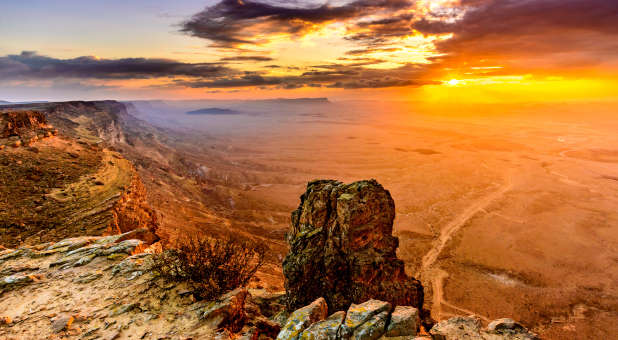Israel’s Negev Desert: Past, Present and the World-Changing Future
Read time: 5 minutes 18 seconds
Ever since the early Zionist settlers, Israel has made the desert flourish, and today it’s a worldwide center of innovation.
Ben-Gurion University of the Negev in Beersheva develops technologies that can be used around the world, attracting agricultural scientists across the globe.
And it all started with Abraham.
The Negev Desert takes up two-thirds of Israel’s landmass, but only 10% of its population lives there. Abraham lived in Beersheva, which today is the largest city in the northern Negev, with a population of more than 200,000 people. The Negev Desert is also the only part of Israel where Moses walked.
He was not allowed into the Promised Land, but the wandering of the Israelites in the desert brought them from the Sinai, through the Negev, from where they sent out the 12 spies, and then were left to wander for 40 years.
The book of Numbers tells the story of the children of Israel going around the land of Edom and conquering the Amorites, and how the king of Moab sent the prophet Balaam to curse them. These lands are all in the modern-day state of Jordan, so the children of Israel must have gone through the Negev at some point.
Eventually, after Moses’ death, they entered Israel by crossing the Jordan River at Gilgal.
This means that the Negev Desert has a significant place in the history of the Jewish people.
This is where God showed His power and might, and sent Manna from heaven, and it’s possible this is the area where the miracle of the copper snake occurred, which Jesus spoke about to Nicodemus in John 3:14-15: “Just as Moses lifted up the snake in the wilderness, so the Son of Man must be lifted up, that everyone who believes may have eternal life in him.”
After Joshua’s conquest, the northern Negev was allotted to the tribes of Judah and Simeon. Later, Solomon extended Israel’s borders all the way to Eilat.
After the Babylonian exile and during the Persian and Greek eras, the Negev was beyond the perimeters of the large empires, being ruled instead by Nabatean tribes who controlled the Negev for their caravan trade routes between Petra and the port of Gaza. Even during the time of Jesus, the Negev was outside the Roman Empire—the Romans didn’t conquer the area until 106 A.D. Over 500 years later, Islam arrived.
Under the Ottoman Empire, the Negev Desert was underdeveloped and neglected for centuries. The Turks had other, much bigger deserts to worry about. Once conquered in 1917 by the ANZAC troops of Great Britain, the Negev became part of the British Mandate of Palestine.
The Peel Commission in 1937 suggested dividing the British Mandate into an Arab and a Jewish state, with the entire Negev to be part of the Arab state. A similar proposal was put forward in 1946. In October of the same year, the Jewish Agency built 11 settlements in the Negev overnight, including a fully functioning water supply system. They hoped that the next division plan would make the Negev part of the Jewish state—and they were right.
The 1947 United Nations Partition Plan did, indeed, include most of the Negev as part of the proposed Jewish state, as there were new facts on the ground. In Israel’s 1948-1949 War of Independence, Israeli troops successfully reached all the way to Eilat, where they flew an improvised Israeli ink flag. The iconic photo that captured the event resembles the 1945 American photo when the U.S. flag was raised in Iwo Jima.
David Ben-Gurion was a driving force in developing and settling the desert. It is no coincidence that the Beersheva university is named after him. When he retired from politics, he moved to Kibbutz Sde Boker, where he was buried.
In his office, Ben-Gurion always had a sheet of paper in front of him with biblical prophecies by Isaiah about making the desert bloom, and a statue of Moses in front of him. For him, planting trees in the desert was the essence of Zionism.
Israel is a small country and because the Negev takes up two-thirds of it it, we don’t have the luxury of not using it, unlike the Ottomans for whom the desert was an insignificant part of their vast empire.
Ben-Gurion was a visionary, and already by the ’50s, he said things about the desert that could sound as if they were written today; using the desert for solar energy; desalinating water from the Red Sea and Mediterranean for example.
These visions are now being carried out. There are a number of large solar fields in the desert and more are being built. Desalination of sea water is already taking place, enabling Israel to export water to neighboring Jordan. Israeli experts are visiting Dubai to share their know-how. Ben-Gurion University students from developing African nations are learning how to develop food and water security in their homelands.
Some estimate that by the year 2050 roughly 700 million people will have been displaced because of scarce land resources and desertification. Israel may have already provided a solution.
As of today, Israel is the only country in the world where the inhospitable desert isn’t growing but shrinking. Large parts of the desert are blooming and Ben-Gurion’s vision is being fulfilled in front of our eyes.
The Jacob Blaustein Institutes for Desert Research, an academic faculty of Ben-Gurion University, is spearheading this effort by developing the know-how to spread to all five continents. Over 50 post-doctoral scholars from over 30 different countries are learning how to survive long-term in a dry area, how to develop solar energy, conserve water and grow food in harsh conditions—all of which is vital for the future of humanity.
The Negev is also geologically unique. Only in the Negev will you find a machtesh—a naturally formed crater. There are three in Israel, the largest one known is the Ramon crater. The bottom of this crater is so similar to the surface of Mars that the European Space Agency and Israel have conducted simulations with potential astronauts there.
With its rich history and amazing potential for humanity’s future, the Negev Desert is truly the past, present and future of Israel—and the world. {eoa}
This article originally appeared on ALL ISRAEL NEWS and is reposted with permission.
 Bring Charisma magazine home with a subscription today!
Bring Charisma magazine home with a subscription today!
Tuvia Pollack is an unpublished writer of historical fiction novels depicting Judeo-Christian relations throughout history. His website is tuviapollack.com.






































